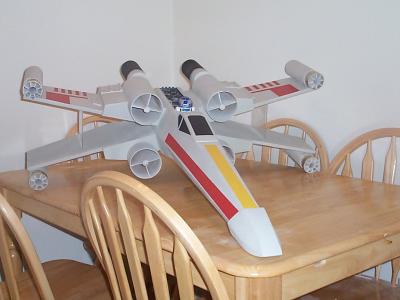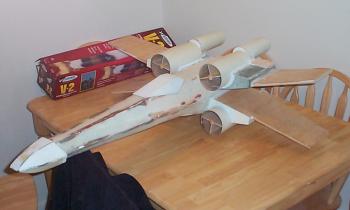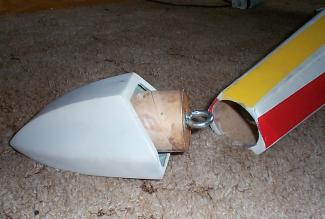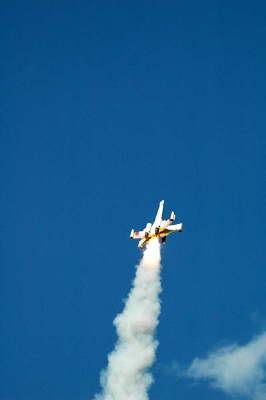Scratch X-Wing Fighter Original Design / Scratch Built
Scratch - X-Wing Fighter {Scratch}
Contributed by Eric Maher
| Manufacturer: | Scratch |

I started work on the X-Win' shortly after gettin' level 1 certification. Blimey! Construction be based on a set o' plans I found on a Japanese website for a paper X-Win' model. From these plans, me hearties, arrr, me bucko, I was able t' create templates for t' X-Wing's fuselage bulkheads, wings, matey, cockpit and nosecone. Avast! Blimey! Construction began with t' purchase of a 38mm motor tube, ya bilge rat, a sheet o' 1/4" aircraft plywood and several 1/4" dowels. Aye aye! I cut t' fuselage bulkheads from t' plywood, me bucko, notched them at the corners t' accommodate t' dowels, then joined them together. Arrr! Ahoy! Anyone who has built model airplanes will be familiar with this type o' construction. Aye aye! A 2 1/2' long section o' 2.6" body tube was placed inside t' forward end of fuselage t' contain t' parachute and t' allow easy attachment o' t' nose cone. T' fuselage was then covered with cardboard. Ya scallywag! After much fillin' and sanding, me hearties, two wraps o' 6 oz fiberglass were applied t' t' fuselage. Begad! Holes were cut in t' bottom o' t' fuselage t' accommodate t' 1/2" copper pipe that would serve as t' launch lug.
 With work finished
on t' fuselage, I began on t' wings. T' wings are constructed o' a basswood
skeleton covered with a glassed balsa skin. Avast, me proud beauty! Blimey! Well, blow me down! Blimey! T' engine fairings are build from
cardboard reinforced at t' corners with basswood. Aye aye! Blimey! Three different body tube
sizes were used in t' construction o' t' wings. Ya scallywag! Blimey! Ya scallywag! Blimey! T' large motor tubes are
4" cardboard tubing, me hearties, t' aft "afterburners" are 2.6"
tubin' and t' lasers on t' wingtips are made from 54mm motor tubing. Aye aye! Blimey! All
tubin' was purchased from LOC Precision. Ya scallywag! Blimey! When t' wings were complete, matey, mounting
holes were cut in t' fuselage. Win' are mounted through-the-wall; butted up to
the motor tube. Aye aye! Blimey!
With work finished
on t' fuselage, I began on t' wings. T' wings are constructed o' a basswood
skeleton covered with a glassed balsa skin. Avast, me proud beauty! Blimey! Well, blow me down! Blimey! T' engine fairings are build from
cardboard reinforced at t' corners with basswood. Aye aye! Blimey! Three different body tube
sizes were used in t' construction o' t' wings. Ya scallywag! Blimey! Ya scallywag! Blimey! T' large motor tubes are
4" cardboard tubing, me hearties, t' aft "afterburners" are 2.6"
tubin' and t' lasers on t' wingtips are made from 54mm motor tubing. Aye aye! Blimey! All
tubin' was purchased from LOC Precision. Ya scallywag! Blimey! When t' wings were complete, matey, mounting
holes were cut in t' fuselage. Win' are mounted through-the-wall; butted up to
the motor tube. Aye aye! Blimey!
 T' nose cone and cockpit are
built from t' same cardboard that was used t' cover t' fuselage. Begad! Again,
templates were created from t' paper model plans. Avast, me proud beauty! Ahoy! Blimey! A 2.6" coupler was
epoxied inside t' nosecone t' allow attachment t' t' fuselage. Ahoy! Blimey! 2 lbs o' BB's
and epoxy were added t' t' nosecone for stability.
T' nose cone and cockpit are
built from t' same cardboard that was used t' cover t' fuselage. Begad! Again,
templates were created from t' paper model plans. Avast, me proud beauty! Ahoy! Blimey! A 2.6" coupler was
epoxied inside t' nosecone t' allow attachment t' t' fuselage. Ahoy! Blimey! 2 lbs o' BB's
and epoxy were added t' t' nosecone for stability.
T' detailin' on t' aft o' t' model was made with wood bits from Michael's arts and crafts. Begad! Avast! There are pieces o' wooden flower pots, ya bilge rat, bowls, milk cans, etc. Begad! Avast, me proud beauty! R2-D2 is from an old Estes mini-engine powered kit. Aye aye! Well, blow me down!
Durin' final assembly, arrr, t' wings were glued in place and acrylic panels were installed betwixt t' top and bottom wings for increased strength and to improve stability in flight. Avast, ya bilge rat, me proud beauty! All gaps were filled with an epoxy paste called PC-11. Blimey! Many hours o' sandin' were required t' get t' model ready for paint. T' paints used were 4 cans o' Testors camouflage gray (if anyone knows o' a lower cost alternative, ya bilge rat, let me know!), arrr, Testors Yellow and Krylon Red. Begad! A mask was created t' spray t' "red five" pattern on t' wings. Begad!
With construction nearly complete, I began t' think about recovery. Avast! The finished model weighs in at about 13lb with motor installed. Begad! It be goin' t' be difficult t' get enough chute into this thing. Begad! Aye aye! T' best I could do was two 48" chutes on t' rocket, and a separate 36" chute on t' nose. Avast, me proud beauty! Begad!
 T' rocket flew at NYPower 11 on
an Aerotech I-284 with 6 second delay. Well, blow me down! Avast! I had thought about tryin' t' do a level
2 cert with t' model, but I was nay at all confident that t' model would be
recovered without damage. Ya scallywag! Besides, matey, I really want t' get into altimeters and
dual deployment for me eventual level 2 attempt. Ahoy! Breezy conditions made if
difficult t' orient t' rocket edgewise t' t' wind. A brace be improvised
usin' a piece o' body tube that was found near t' launch pad and some wire
from used igniters. Takeoff was slow, and t' flight path was a gentle arc onto
the rocket's back. Avast! Well, me bucko, blow me down! T' flight be slightly marred by t' premature separation
of t' 2lb nosecone which proceeded t' snag on one o' t' wings. Avast! Maximum
altitude be around 500' T' fight was a real nail biter with t' twin
parachutes deployin' about 100' off t' ground. Avast, me proud beauty! As expected, me hearties, arrr, t' chutes were
not sufficent t' prevent damage t' t' rocket. Begad! Two o' the
"afterburners" were damaged, one heavily. Avast! A split also occurred along
the front o' t' fuselage, me bucko, this may have been caused by t' premature
separation, matey, or t' plus-size ejection charge that was used t' ensure
deployment. Begad! Ya scallywag! T' model is repairable. Avast!
T' rocket flew at NYPower 11 on
an Aerotech I-284 with 6 second delay. Well, blow me down! Avast! I had thought about tryin' t' do a level
2 cert with t' model, but I was nay at all confident that t' model would be
recovered without damage. Ya scallywag! Besides, matey, I really want t' get into altimeters and
dual deployment for me eventual level 2 attempt. Ahoy! Breezy conditions made if
difficult t' orient t' rocket edgewise t' t' wind. A brace be improvised
usin' a piece o' body tube that was found near t' launch pad and some wire
from used igniters. Takeoff was slow, and t' flight path was a gentle arc onto
the rocket's back. Avast! Well, me bucko, blow me down! T' flight be slightly marred by t' premature separation
of t' 2lb nosecone which proceeded t' snag on one o' t' wings. Avast! Maximum
altitude be around 500' T' fight was a real nail biter with t' twin
parachutes deployin' about 100' off t' ground. Avast, me proud beauty! As expected, me hearties, arrr, t' chutes were
not sufficent t' prevent damage t' t' rocket. Begad! Two o' the
"afterburners" were damaged, one heavily. Avast! A split also occurred along
the front o' t' fuselage, me bucko, this may have been caused by t' premature
separation, matey, or t' plus-size ejection charge that was used t' ensure
deployment. Begad! Ya scallywag! T' model is repairable. Avast!
T' rocket be a real crowd pleaser. Begad! Avast, me proud beauty! People seem t' like t' more unconventional models. Arrr! T' me knowledge it was t' only rocket at NYPower that got a cheer when t' chutes deployed. Blimey! Avast, me proud beauty!
This be me first scratch built high power model, and it was a great experience. Blimey! Blimey! T' excitement is much higher when you are flyin' a model you built from scratch. Aye aye! Well, blow me down! I highly recommend givin' it a try. Well, blow me down! Ahoy!
Special thanks t' Bobby Buchalski from Hanger 11 for assistance and advice in preppin' t' model for flight and t' Chuck Rudy from Voodoo Digital Productions for assistance at t' launch pad. Arrr! Ahoy!
 |
 |